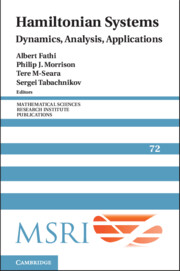Book contents
- Frontmatter
- Contents
- Denjoy subsystems and horseshoes
- Impact Hamiltonian systems and polygonal billiards
- Some remarks on the classical KAM theorem, following Pöschel
- Some recent developments in Arnold diffusion
- Viscosity solutions of the Hamilton–Jacobi equation on a noncompact manifold
- Holonomy and vortex structures in quantum hydrodynamics
- Surfaces of locally minimal flux
- A symplectic approach to Arnold diffusion problems
- Hamiltonian ODE, homogenization, and symplectic topology
Holonomy and vortex structures in quantum hydrodynamics
Published online by Cambridge University Press: 10 May 2024
- Frontmatter
- Contents
- Denjoy subsystems and horseshoes
- Impact Hamiltonian systems and polygonal billiards
- Some remarks on the classical KAM theorem, following Pöschel
- Some recent developments in Arnold diffusion
- Viscosity solutions of the Hamilton–Jacobi equation on a noncompact manifold
- Holonomy and vortex structures in quantum hydrodynamics
- Surfaces of locally minimal flux
- A symplectic approach to Arnold diffusion problems
- Hamiltonian ODE, homogenization, and symplectic topology
Summary
We consider a new geometric approach to Madelung’s quantum hydrodynamics (QHD) based on the theory of gauge connections. Our treatment comprises a constant curvature thereby endowing QHD with intrinsic nonzero holonomy. In the hydrodynamic context, this leads to a fluid velocity which no longer is constrained to be irrotational and allows instead for vortex filaments solutions. After exploiting the Rasetti–Regge method to couple the Schrödinger equation to vortex filament dynamics, the latter is then considered as a source of geometric phase in the context of Born–Oppenheimer molecular dynamics. Similarly, we consider the Pauli equation for the motion of spin particles in electromagnetic fields and we exploit its underlying hydrodynamic picture to include vortex dynamics.
In his seminal work [5], Berry discovered that after undergoing an adiabatic cyclic evolution, a quantum system attains an additional phase factor independent of the dynamics and depending solely on the geometry of the evolution, since referred to as Berry’s phase. This discovery opened up an entire field of study of the more general concept of geometric phase which has since been found to comprise the underlying mechanism behind a wide variety of physical phenomena, in both the classical and quantum domains. A key example of each is the Pancharatnam phase in classical optics, [72], which has been experimentally verified using experiments involving laser interferometry [6] and the celebrated Aharonov–Bohm effect of quantum mechanics, discovered in 1959 [3] and experimentally verified in the late 1980s [94], which was given a geometric phase interpretation in [5]. One particular discipline which has benefited greatly from the understanding of geometric phase is quantumchemistry,
in which the separation of the molecular wavefunction into nuclear and electronic components gives rise to geometric phase effects in an array of phenomena [67], perhaps most famously including the Jahn–Teller effect [49; 59]. To this day there is extensive research into the role of the geometric phase in quantum systems and in particular the application to molecular dynamics in quantum chemistry [1; 2; 33; 67; 78; 80; 81; 82].
Information
- Type
- Chapter
- Information
- Hamiltonian SystemsDynamics, Analysis, Applications, pp. 173 - 214Publisher: Cambridge University PressPrint publication year: 2024
